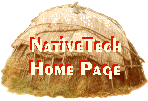
Single Wrapped Feathers

|
Single Wrapped Feathers |
|
Traditional | Contemporary Prairie | Contemporary Eastern | Contemporary Northeast |
... A little about Native American Featherwork
Native Americans have an infinite number of decorative uses for feathers. Featherwork often incorporates other materials such as leather, thread, and even animal hair. Decorated feathers are often tied to a lock of hair, placed upright on top of a cap, fastened to a headband or worn from the ears. In the 1600s, some New England Native men wound their long hair up around feathers "worn broad-wise, like a fan" (Mourt in Heath 1986). Both turkey and eagle feathers were attached to hair of New England Native Americans. Single feathers are embellished and then combined to make beautiful head, neck and clothing ornaments as well as fans and dance bustles. Feathers and bird skins are even used to make clothing. Very prominent and easily seen, feathers communicate particular messages to the onlooker. Certain kinds or ways of cutting feathers, or particular numbers of feathers may indicate a person's tribe, clan, or status. Many feathers have important ceremonial and religious importance. Decorated feathers from particular birds are sometimes attached to sacred tobacco pipes or used in altar displays during ceremonies. Decorated feathers may be used as ‘smudge’ feathers, used to direct the purifying smoke of burning cedar, sage, tobacco and/or sweetgrass.
Animal hair from the deer, moose and other creatures are also used in Native American featherwork. Animal hairs are intricately tied, braided, and woven into decorations for the head and neck. In the 1600’s, Europeans describe Native American men wearing such ornaments made of red dyed animal hair . . . "made in the fashion of a cock’s comb died red, crossing their heads like a half moon" (Gookin 1970). This hair is described as beautiful, some long, coarse and stiff [porcupine guard hair or moose hair], and some shorter and very fine [deer] (van der Donck 1968). Europeans likened these woven hair bands or roaches to the paintings of halos worn by Catholic saints (van der Donck 1968). Contact period headbands of birchbark or leather also incorporated feathers and animal hair. Tufts of dyed deer or other hair were also wrapped into feathers or inserted into metal tinkling cones for neck or clothing decorations.
Of all birds of prey, Native Americans give eagles the greatest honor. There are many species of eagles recognized by Native Americans, including some types of vultures, considered to be the fourth eagle by some Native Nations. Other birds of prey, including the many types of hawks, also carry important meanings. For example, some Native Americans associate owl feathers with death or prophesy, but to other Natives, if an owl feather is combined with a hawk feather, it represents life.
Early historic records of Northeastern North America mention a little black bird resembling a hawk that was instilled with great courage despite its small size. ‘They are so strangely courageous and hardy, that nothing flyeth in the Air that they will not bind with’ (citing Josselyn in Lindholdt 1988). In the 1600’s New England travelers reported seeing this little black hawk worn upon the heads of Native Americans. The little bird had the same Narragansett name as the word for their political leader, ‘Sachim’, because of the bird's ‘princelike’ courage over greater birds . This hawk was valued at an amount sufficient to ransom a ‘Sagamour’, a Native American leader (Wood 1865).
Although birds of prey are revered by Native Americans, game and song birds are also appreciated for their own particular qualities. Game birds, like the turkey, goose and duck, are very prevalent in Native American featherwork. In the Northeast, in addition to arrow fletching, upright turkey-tail headdress, single wing- and tail feather decorations, ceremonial fans and other items, turkey feathers are also woven together into capes. Noted in the 1600’s, Native Americans of the Northeast sometimes wore a covering made of turkey feathers during the winter months. Records describe these mantles, capes, or coats "knit together very oddly, with small strings" (de Rasieres 1967). Perhaps plaited together, the turkey feathers overlapped like that the back of the bird. Woven by women for their children, "they make likewise some Coates of the Feathers of Turkies, which they weave together with twine of their owne makinge, very prittily: these garments they weare like mantles knit over their shoulders, and put under their arme" (Morton 1964).
Song bird and other exotic bird feathers are prized by Native American for certain characteristics. The feathers of blue jays, cardinals, and some other brightly colored birds are used for their medicine by spiritual leaders. Medicinal teas are made by steeping or boiling particular feathers in water. In the 1600’s, a humming bird was worn as an ear pendant by a Northeastern Native American leader (Wood 1865). Native Americans in the Northeast also accepted peacock feathers and ostrich plumes in trade, and wore them in traditional Native styles.
Native Americans in New England left no part to waste when an animal was killed. What could not be consumed of an animal, bird or other beast was utilized as a means to embellish items produced by Native Americans in southern New England. The feathers of birds and hair of animals was no exception in the vast array of materials used in their material culture. Birds are well documented as decorative elements in the arts of Native Americans of southern New England. It is no surprise that the feathers of birds and entire small birds were highly esteemed for adornment and symbols of status.

© 1994-2000 Tara Prindle.